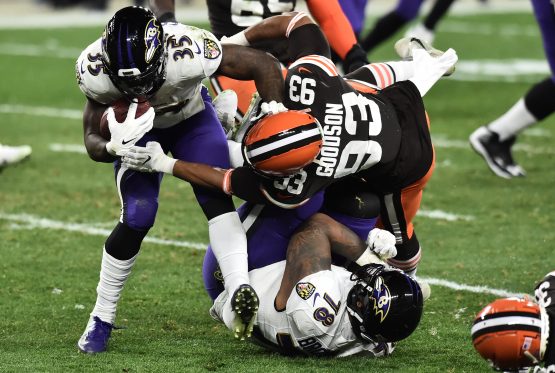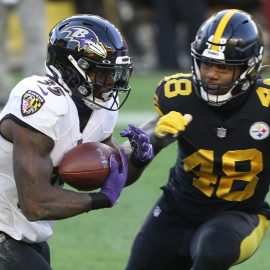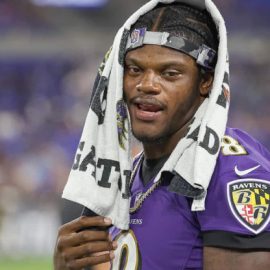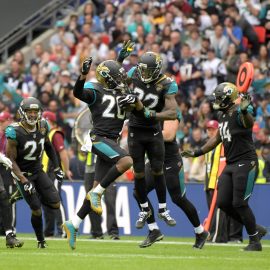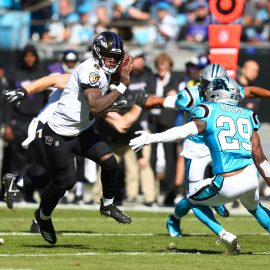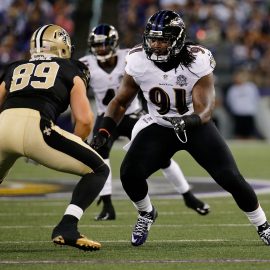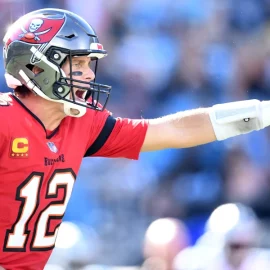Jerry Coleman’s podcasts with sidekick Jason La Canfora have been getting into some real NFL depth, and we have encouraged our readers in the past to check out the show:

For those who don’t know, Jerry Coleman is one of my favorite radio personalities covering the Baltimore Ravens and Baltimore sports in general. He’s been working the Baltimore beat for about 25 years now but still has a young and enthusiastic approach to his job. He’s not shy about expressing opinion or criticism of the teams he covers—especially the Ravens. You can hear him most often these days between 6 and 10 p.m. on the CBS FM Radio affiliate 105.7 The Fan.
It just so happens that NFL analyst Jason La Canfora is a neighbor of Jerry’s, and the two get together on a regular basis to produce a smart podcast chock full of inside football talk and live interviews with NFL players.
You probably know La Canfora pretty well from his NFL Network TV takes, but he’s even more entertaining and informative in the podcast format. Coleman you may not know so well yet—let’s just say he’s an acquired taste. Imagine the voice of a young Howard Cosell coming out of the face of a young Jerry Lewis—that’s Jerry Coleman.
Anyway, Coleman and La Canfora got these parting shots from former Ravens fullback/H-back Kyle Juszczyk (whom shall be called “Juice”) who signed with a new team in recent free agency transactions—“Juice” to the 49ers with a major pay raise to about $5 million for the 2017 season.
I don’t want to say Coleman’s interview dug up a lot of sour grapes—but it did reveal the natural disappointment of a dedicated professional who thought he was under-utilized and unappreciated in the Ravens offense.
Harvard graduate “Juice” had some systemic criticism:
“During our press conference, [49ers General Manager] John Lynch referred to me as an ‘offensive weapon’ and said that, ‘He’s not your typical fullback.’ Honestly, that was music to my ears,” Juice told the BmoreOpinionated Podcast.
“That’s everything I’ve wanted to hear these last couple of years just because I feel like that label as a fullback almost holds you back a little bit. It pins you into a certain type of player. I feel like to some degree people kind of look down on it because the whole, ‘Fullbacks are extinct. How many teams in the NFL even use a fullback nowadays?’ But it’s not necessarily the only position that I’ve played on offense. To kind of get rid of that label really means a lot and plays into my game.”
Juszczyk told Coleman and La Canfora that he had conversations with his four different Ravens coordinators and head coach John Harbaugh about his role. He said they all agreed that he could be used as more than a traditional fullback, and at times that happened. He was used on special teams, in third-down protections as a halfback on offense and split out or lined up in the wing. He caught 78 passes over the past two seasons. But Juszczyk said that only happened in a couple games here and there, and it “never came to full fruition.”
“Every player wants to be utilized to their full potential, and I feel like when I was with Coach Kubiak that was something that I got to experience,” Juice said. “I thought that maybe at least one more time before I retired, I’d get a shot to play with [former Ravens OC Gary] Kubiak again, but when he retired, that kind of seemed like that was all up in the air and that wasn’t going to happen. But then this opportunity rolled around with Coach Shanahan. I mean, really, it’s kind of like the same thing. It’s a very similar offense and I think this is my opportunity again to be fully utilized.”
La Canfora asked Juice if the Ravens had offered him $2.5 or $3 million heading into his 2016 contract year, would he have taken it? After all, it would have been top dollar for a fullback. [Juice ended up signing with San Francisco on a 4-year, $21 million deal.]
“My agent and I joke about that all the time now,” Juszczyk said. “I don’t know for sure if I would have taken it because I do like when players bet on themselves and believe in their potential and what they can do. But I also can’t say for sure that I wouldn’t have taken it because that’s a lot of money and, at the time, the fullback market is not much more than that. I didn’t really know exactly what I was going to get when I did hit free agency, but good thing I did let it play out because things really worked out the best.”
Meanwhile, in Indianapolis it was Kamar Aiken‘s turn…the former Ravens wide receiver has signed on with the Colts. He threw some flame at the Ravens offense, too.
Aiken was frustrated with his role in the Ravens offense after he went from 127 targets in 2015 to 50 last season. [Aiken told Indianapolis media that he was promised by Colts General Manager Chris Ballard that he’ll have the opportunity to compete for serious playing time. He believes Ballard will keep his word.]
“I’ve never had that in my career since I’ve been in the league, to be honest,” Aiken said, per Indystar.com. “A lot of times teams will tell you, ‘Yeah, it’s competition,’ and it really isn’t competition. I believe what [Ballard] said, it’s going to be a competition and the best guys will play. I think that’s good for the whole room in general. It’s going to bring everybody’s play up.”
The competition for meaningful playing time in Indianapolis is expected to be intense with other receivers on the roster like T.Y. Hilton, Donte Moncrief, Phillip Dorsett and Chester Rogers.
Aiken said the Ravens’ opportunities were just never given to him in Baltimore unless there were injuries to players ahead of him on the depth chart. “It was definitely frustrating because I felt like I did enough to at least have the opportunity to build off of what I did the year before,” Aiken said, per Fox 59 in Indianapolis. “But I really didn’t have that. My role was dropped back on the depth chart and then basically special teams. There was nothing that I was doing to say, ‘Well, he’s not doing this well. He’s not doing that well.’ That’s just what it was. I just got in there Week 1, and the next thing you know, I look at the depth chart and now I’m back [down] the depth chart.’’
Add The Sports Daily to your Google News Feed!

